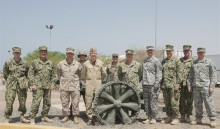(The Boy Scouts of America Communications Department was not involved in the creation of this content.)
Once an Eagle, Always an Eagle; Deployed Military Members take Pride in Heritage
By Staff Sgt. Leslie Keopka
CJTF-HOA
August 22, 2014

Eagle Scout service members deployed to Combined Joint Task Force-Horn of Africa and Camp Lemonnier pose for a group photo Aug. 22, 2014, at Camp Lemonnier, Djibouti. (U.S. Air Force photo by Staff Sgt. Leslie Keopka)
More than 2.3 million Boy Scouts have earned the rank of Eagle Scout and of those, several are deployed to Combined Joint Task Force-Horn of Africa and Camp Lemonnier, Djibouti.
To become an Eagle Scout, one must go through all the scout ranks, earn 21 mandatory merit badges, plan, develop and execute a final community service project and complete an Eagle Scout board of review.
The merit badges include: first aid, communication, fitness, camping, family life and wilderness survival.
U.S. Navy Capt. Michael Newman, Camp Lemonnier commanding officer and native of Oakland, Calif., entered into the program at age seven and became an Eagle Scout at age 16 while living in Golden, Colo.
Becoming an Eagle Scout taught him valuable skills he uses in his career today, he said.
“I think Scouting is great in the idea of organizational skills and leadership, but the other piece is outdoor activities and getting into camping, backpacking, and wilderness activities,” Newman said. “Some of those wilderness skills you actually use as a pilot when you go to [Survival, Evasion, Resistance and Escape] school and some of the other training you do; it isn’t the first time you are out there starting a fire or eating bugs.”
Petty Officer 1st Class Michael Urban, Detail Special Operations Command Africa Naval Mobile Construction Battalion 133 operations chief and native of Philadelphia, Pa., entered into the program at age 10 and became an Eagle Scout at age 17.
Urban earned 34 merit badges that included community service, safety and first aid. He said just about everything he does as a Seabee, there is a merit badge for.
“It is almost like military boot camp, just without the yelling and screaming,” Urban said. “The Boy Scouts introduced me to discipline, organizations and formations.”
U.S. Air Force Lt. Col. Rick Fournier, Combined Joint Task Force-Horn of Africa Air Component Coordination Element duty director and native of Deridder, Louisiana, entered into the program at age seven and became an Eagle Scout at age 16.
Fournier has two sons in the program now and gave advice to future and current Scouts.
“Keep working toward the Eagle Scout; don’t look back and wish you had made Eagle, get Eagle,” Fournier said. “You never stop being an Eagle Scout. It is just the starting point for something to carry with you the rest of your life. You have to be a representative of that.”
Fournier earned the aviation merit badge during his time in the program and says it made him interested in becoming the pilot he is today.
For more information on Boy Scouts of America and Eagle Scouts, please visit http://www.scouting.org/.

